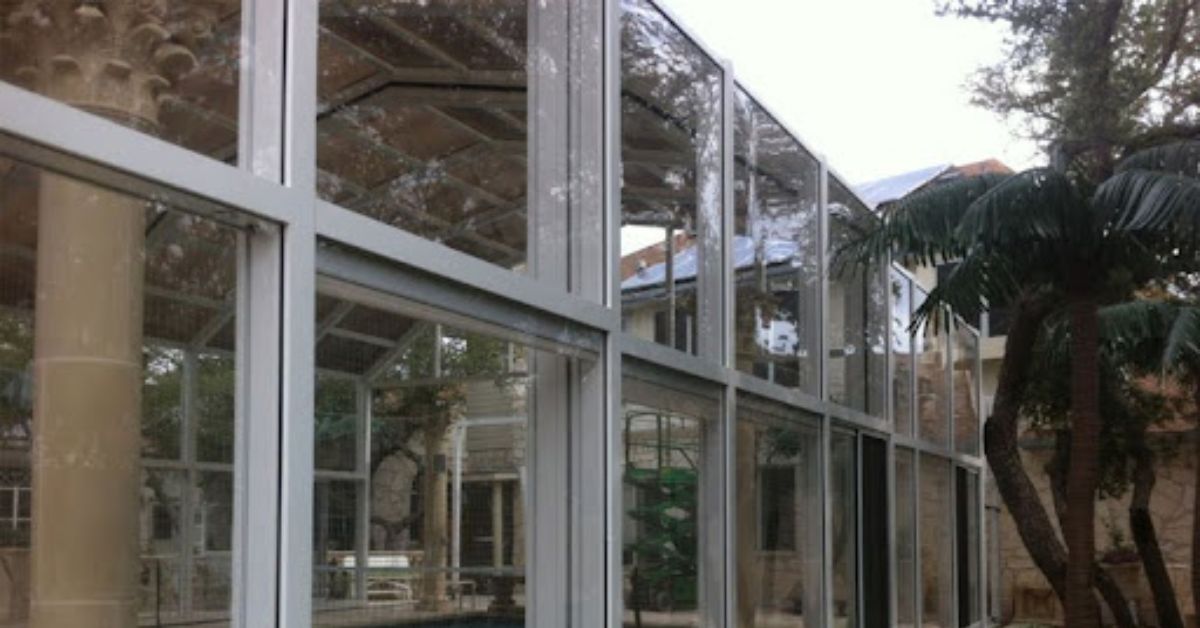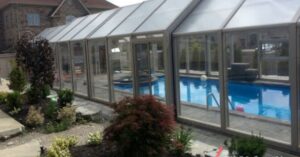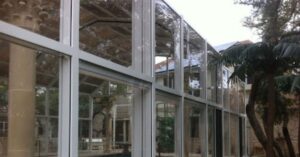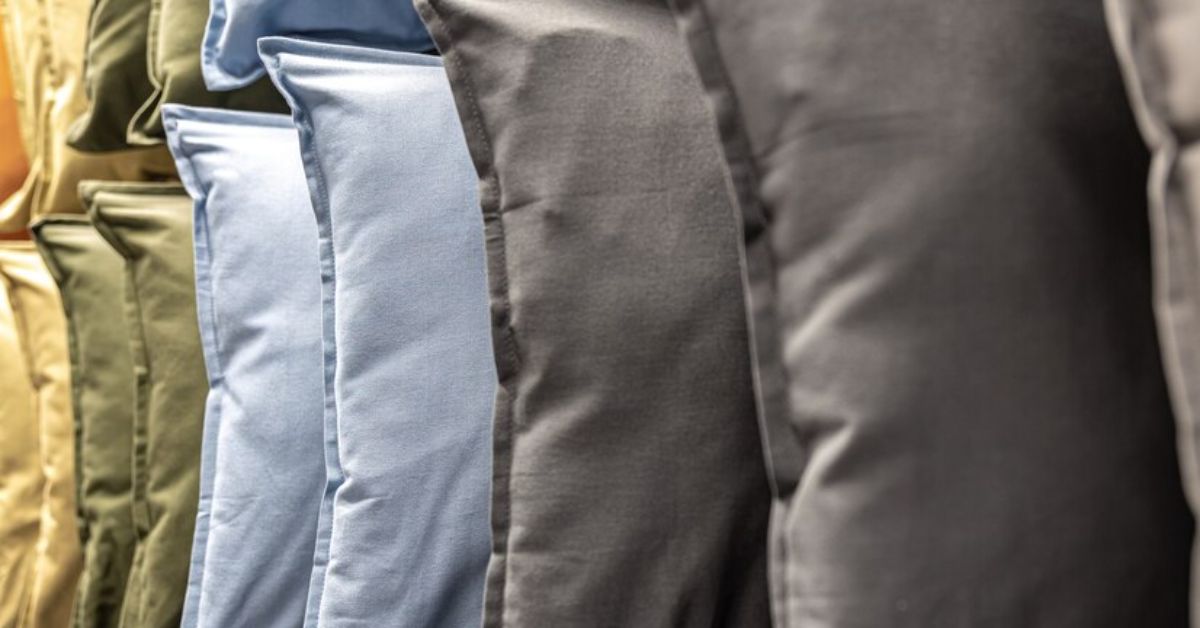HOME IMPROVEMENT
The Inextricably Deep World of Vaporwave

My first encounter with the strange music genre of vaporwave happened when I was about 14, scrolling through the gritty meme recess that was iFunny. I remember seeing photos that all had the same sort of elements: an Apollo head bust, a cyber grid of neon colors, palm trees, and outdated fonts. These were strangely captivating, but also unsettling.
Usually these photos were accompanied by music that I could only describe as the kind of elevator music that must have played in a hotel that was built in 1983, and is in desperate need of a renovation. It wasn’t until just recently that my boyfriend taught me the name of the album that the strangely haunting elevator music came from: Floral Shoppe by Macintosh Plus. As it turns out, the nostalgia-inducing images and music that captivated me as a 14-year-old were all part of a budding genre of music called vaporwave, and I was very right to feel unsettled.
WHAT IS VAPORWAVE?
Vaporwave is both an aesthetic and genre of music that is meant to induce nostalgia, especially for the ’80s and early ’90s, and a longing for what we imagined the future would be like back in the 1980s. The driving theme behind vaporwave is that it makes you long for a future that never happened. Vaporwave music is often composed of samples of songs from the 1970s and 80s. These are usually pitched down, slowed, and resynthesized in order to create a thick heavy sound, like something is weighing you down and pulling you back in time.
One distinctive feature of vaporwave is its fixation with Japanese language and culture. There are countless album and track titles in cryptic Japanese, which are more often than not completely unreadable to the mostly Western audience of vaporwave. Many artists even sample clips of dialogue from retro Japanese anime films, commercials, and news reels. This element of vaporwave is also tied up in its constant pursuit of awakening nostalgia. Japan enjoyed an economic boom throughout the 1980s, which is now recognized as Japan’s Bubble Economy, that would eventually come crashing down in the 1990s. Before this devastating pop, Japan was praised for its thriving business models and became a model of technological innovation in the western mind for more than a decade.
Additionally, with the success of entertainment and tech industries like Sony and Nintendo, Japan appeared to be the country that was building the future, one that looked shiny, new, and full of promise.
Perhaps the best way to understand the nostalgia-obsessed mess that is vaporwave is through Jaques Derrida’s concept of Hauntology, as proposed in “The Philosophy of Vaporwave” by the website Vapor95. According to Derrida, humans can only understand the present through past experiences and anticipation of the future. Therefore, humans never truly live “in the moment.” What we understand to be the present is always defined by our pasts along with what we anticipate to follow in the future, and is thereby never truly “just” the sensations at present. In other words, the concept of Hauntology is that humans are always haunted by the past and the futures that have yet to happen.
This tendency to filter the present through our past experiences is what gives vaporwave that undeniably nostalgic sound. Most of us have heard old music from decades long gone by. For example, if a song is full of synth and heavy reverb, you will likely identify it as some musical relic of the ’80s, which will then open up a floodgate in your mind of your experience with ’80s culture, whether that be other songs, movies, or photos of your parents from that time. To hear these outdated musical trends once again given new life through being resynthesized and paired with grainy imagery from these decades is like rolling up your sleeve and shooting your arm up with the heaviest dose of nostalgia.
SOME BRANCHES OF VAPORWAVE
The vaporwave genre is laden with subgenres, some of which are so similar that it feels superfluous to differentiate them at all. However, as someone who has listened to vaporwave for a few years now, here are some of the subgenres that I personally think deserve to be recognized, as they exemplify the many sides of the genre, ranging from ethereal or funky to downright creepy.
FUTURE FUNK
Future Funk is the more jovial branch of vaporwave. It often samples from the choruses of funk and motown music from the ’70s and early ’80s, and especially uses シティ・ポップ (City Pop), which is essentially just pop music from 1980s Japan. Future Funk sounds like what you’d imagine playing at some raging night club in the late ’70s, where everyone is young, beautiful, and having the time of their lives. Simply speaking, It’s the kind of stuff that makes you want to dance.
In the Mallsoft genre, vaporwave allows listeners to reflect on society, especially on consumerism and the influence it has on the way we experience nostalgia. If you search up “Mallsoft” on YouTube, you will be inundated with sweeping shots of lush malls aesthetically decorated with palm trees and fountains at every corner. These are the malls that some of us might remember from shopping with our parents in the late ’90s or maybe even early 2000s. As Pad Chennington, a vaporwave music producer who also runs a Youtube channel dedicated to analysis of the genre, says in his video The Hyperconsumerism of “Mallsoft”, “hyperconsumerism is an unavoidable aurora of the 80s and 90s shopping world we all once lived in, provoked by the shop ‘til you drop atmosphere of those big mean department stores and malls all across America.” Chennington goes on to argue that as technology progressed, shopping became dominated by online retailers. which has led to essentially the death of the shopping mall.
The absence of that large comforting presence drenched in shopper’s high that was once the American shopping mall has left a nostalgic hole in our hearts. This emptiness bred the genre of Mallsoft. Musically speaking, Mallsoft is essentially jazzy elevator music, reverb-ed to high hell so that it sounds like it’s being blasted on speakers and echoing throughout some desolate mall, a relic of the ’80s. As you might imagine, it can sound like cheery background music or like what might play during the end credits to the end of time. Mallsoft plays into the nostalgia we have around shopping malls, romanticizing while poking fun at our consumerist nature.
VAPORTRAP
As you might have already deduced by the name, Vaportrap is a fusion of vaporwave and trap music. Vaportrap is what you put on to party, but in a thoughtful way. Much in the vein of Vaporwave, Vaportrap utilizes sound bites that are meant to induce nostalgia through memories of older technology. For example, many Vaportrap songs construct beats around sound effects from old Nintendo 64 games or the notorious Windows 95 boot up sound. However, it is also driven by hard-hitting, relentless beats that make you want to rave.
AMBIENT
Ambient vaporwave on the other hand, is not typically the type of music that you would turn on to jam out to. It usually features nature sounds, heavy synth, and frequencies. As the name indicates, ambient vaporwave focuses more on creating ambience, on building an auditory landscape that you could sink into.
SYNTHWAVE
Synthwave is one of my personal favorite subgenres of vaporwave. This subgenre is full of synth and mesmerizing beats. Perhaps the best way to define what synthwave sounds like is to first start off with the aesthetic that is inseparable from the music. If you google “synthwave,” you’ll likely see a thousand suns overlooking a thousand different cybergrid horizons. Because of its smooth, repetitive rhythm, synthwave is regarded as the perfect music to drive to if you want to lose sense of time while feeling like the protagonist in a cyberpunk dystopia movie, happily (but thoughtfully) driving away as the end credits roll.
SO WHY SHOULD YOU CARE ABOUT THIS AT ALL?
I regard vaporwave as different from the other genres of music I listen to. If I had to describe the feeling I have towards vaporwave, I’d say it’s morbid curiosity. To me, vaporwave is a lot more like walking into an art museum than turning a playlist on shuffle, but that’s exactly why I always come back to it. The concept behind vaporwave is trying to get in touch with the future as we imagined it in the ’80s and early ’90s, but doing this through musical artifacts of the past, creating a heavy dissonance and the sense of being lost in time. I can’t say that I’ve experienced even a single day of the 1980s, and if you’re reading this, chances are that you might not have either. So, why am I, like so many other young westerners, attracted to this weird, cryptic genre of music?
Are we all so dissatisfied with our present that we’d rather retreat back into a past that none of us have personally known? Do we want to get in touch with the sense of hopefulness and promise that the future was regarded with back in the days when our parents were teenagers? These fatalistic takes do seem to intersect with Generation Z’s undeniable fascination with all things retro, which has revived the record industry, fashion from the ’80s and ’90s, and old sounding music.
However, as we all know from watching sci-fi movies that took shots at predicting what capitalist dominated futures we had in store for us, like Back to the Future Part ll, Blade Runner, or Brave New World, often the future never holds the things early generations imagined it would and many times, that’s for the better. So, no, I don’t think my generation is hopelessly depressed and longing for the past. I do think however, that the past is always comforting, by virtue of it having already been experienced and therefore being known to us. The past holds no surprises, but can stand as something we can look back on reflectively through the rose-colored glasses of nostalgia.
Vaporwave is a genre of music that plays with this truth. It is overflowing with a strange, synthetic sense of nostalgia reminding us that maybe the past wasn’t as sweet as we remembered it, and maybe the future never played out like we thought it would. But, oh, isn’t it fun to pretend if only for a little while?
VAPORWAVE STARTER PLAYLIST
When it comes to music, words can only do so much. So, for anyone who doesn’t mind falling into the rabbit hole that is vaporwave, I’ve made a Spotify playlist and Youtube playlist full of tracks from the genres I mentioned above! Unfortunately, many vaporwave tracks and albums can only be found on Youtube, so the two are not identical to each other. For anyone interested or who has the time, check out both!
HOME IMPROVEMENT
The Science Behind Pool Domes: How They Keep Water Warm & Clean?

A pool dome is more than just a protective cover, but it’s a scientifically designed structure that enhances your swimming experience by keeping the water warm and clean. Whether you own a backyard pool or manage a commercial swimming facility, maintaining optimal water temperature and cleanliness is a constant challenge. Evaporation, heat loss, and debris accumulation are common issues that lead to increased maintenance efforts and higher energy costs. Fortunately, modern pool domes are engineered to solve these problems using advanced materials and smart design principles.
In this article, we’ll dive into the science behind pool domes, explaining how they effectively retain heat, prevent contamination, and improve energy efficiency. Ultimately making them a must-have addition for pool owners.

How Pool Domes Trap Heat?
Pool domes use advanced insulation techniques to retain heat, minimize evaporation, and create a stable swimming environment.
1. The Greenhouse Effect
Pool dome functions similarly to a greenhouse. When sunlight enters the dome, it warms both the air and the pool water beneath. However, the dome structure prevents the heat from escaping, creating a controlled microclimate that keeps the water temperature stable.
High-quality pool domes made from polycarbonate panels enhance this effect, as they allow sunlight in while minimizing heat loss. The result? A naturally warmer pool without excessive heating costs.
2. Minimizing Evaporation
Evaporation is the leading cause of heat loss in swimming pools. Without a dome, water constantly evaporates, carrying heat away with it. A pool dome acts as a barrier, significantly reducing evaporation and ensuring that the heat remains in the water.
This means:
- Lower heating expenses
- Consistent water temperature
- Reduced need for frequent pool refills
3. Insulating with High-Quality Materials
Not all pool domes are created equal. Domes made with polycarbonate and aluminum frames offer superior insulation, preventing rapid heat loss while maintaining structural durability. Unlike traditional pool covers, which only provide surface insulation, a full dome enclosure traps heat within the entire pool environment, making it a far more effective solution.
How Pool Domes Prevent Water Contamination?
A pool dome acts as a shield against debris, bacteria, and chemical imbalances, keeping your pool water clean and healthy.
1. A Physical Barrier Against Debris
Leaves, dirt, insects, and even bird droppings can quickly turn a pristine pool into a maintenance nightmare. A pool dome acts as a shield, keeping unwanted debris out. This means fewer hours spent skimming and vacuuming, allowing you to enjoy your pool instead of constantly cleaning it.
2. Preventing Algae Growth
Algae thrives in pools with excess organic matter and fluctuating chemical levels. Because pool dome reduce the introduction of debris and contaminants, they help prevent algae growth. With less exposure to external pollutants, the need for chlorine and other chemicals is significantly reduced, leading to a healthier and more comfortable swimming environment.
3. Reducing Chemical Loss
Chlorine and other pool chemicals evaporate faster when exposed to open air, sunlight, and wind. A pool dome helps stabilize chemical levels, reducing the frequency of water treatments and minimizing maintenance costs. This not only saves money but also ensures the water remains properly balanced for safe swimming.

Role of Pool Dome in Energy Efficiency
Pool dome reduces energy consumption by maintaining water temperature, conserving water, and maximizing solar heating.
1. Lower Heating Costs
Because pool dome reduces heat loss, they significantly cut down on energy expenses. Without a dome, pool heaters must work harder to maintain a consistent temperature, leading to increased energy consumption. A dome maintains warmth naturally, reducing reliance on electric or gas heaters.
2. Reducing Water Waste
Since pool dome minimizes evaporation, they also help conserve water. Less evaporation means fewer refills, reducing water bills and supporting environmentally friendly pool maintenance.
3. Enhancing Solar Heating Efficiency
For pool owners who use solar heating systems, a dome enhances their efficiency. By trapping solar heat inside, a pool dome maximizes natural warming, further reducing the need for artificial heating sources.
Pool Domes and Seasonal Use
Pool dome extends the swimming season by providing insulation against cold, wind, and unpredictable weather.
1. Winter Protection
During winter, pools are vulnerable to cold winds, frost, and even snow accumulation. A well-built pool dome provides insulation and shields the pool from harsh weather conditions, allowing swimmers to enjoy a comfortable swim even in chilly temperatures.
2. Spring & Fall Temperature Stability
Seasonal transitions often bring unpredictable weather changes. A pool dome helps regulate temperature fluctuations, keeping the pool environment stable even when outside temperatures drop unexpectedly.
3. Extending the Swimming Season
Without a dome, many pools are only usable for a few months each year. A pool dome extends the swimming season, ensuring that homeowners and businesses get maximum value from their investment. Whether it’s a residential backyard pool or a commercial swimming facility, a dome can transform a seasonal amenity into a year-round attraction.
Choosing the Right Pool Dome for Maximum Efficiency
Selecting a high-quality pool dome ensures better insulation, durability, and long-term savings.
1. Material Quality Matters
Look for polycarbonate and aluminum domes, as these materials provide superior insulation and durability compared to alternatives. Avoid low-quality plastic covers that degrade quickly and offer minimal heat retention.
2. Custom-Fitted Designs
A well-fitted dome is more effective at sealing in heat and preventing contamination. Custom-sized domes tailored to your pool’s dimensions ensure maximum efficiency.
3. Ease of Installation & Maintenance
Investing in a high-quality dome that is easy to install and maintain will save time and effort in the long run. Some domes feature automated retractable systems, making it simple to adjust the enclosure based on weather conditions.
Why Covers in Play Offers the Best Pool Dome Solutions?
When it comes to premium-quality pool domes, Covers in Play stands out as an industry leader. Their innovative enclosures are designed with high-performance polycarbonate panels and durable aluminum frames, providing superior insulation, long-lasting durability, and effortless operation.
Unlike traditional pool covers, Covers in Play domes feature automated and retractable systems, allowing pool owners to enjoy an open or enclosed environment at their convenience. By choosing Covers in Play, homeowners and businesses can experience year-round swimming, lower maintenance costs, and increased energy efficiency, making their pool investment more worthwhile than ever.
Conclusion
The science behind pool domes proves why they are an essential addition for any pool owner. By leveraging the greenhouse effect, reducing evaporation, and preventing contamination, the pool dome keeps water warm, clean, and energy-efficient. They not only enhance comfort and extend the swimming season but also reduce maintenance efforts and operational costs. Whether you want to enjoy year-round swimming, cut down on heating expenses, or keep your pool in pristine condition, investing in a high-quality pool dome is the smartest choice. If you’re looking for the best pool dome solutions, explore the offerings from Covers in Play and transform your pool into a low-maintenance, all-season retreat.
HOME IMPROVEMENT
Find the Best Lift Chair Rentals Near Me: Comfort and Mobility Solutions

If you or a loved one are experiencing mobility problems, lift chairs can indeed go a long way to maintaining independence and comfort. These chairs with a motorized lift to assist users to sit down and up are especially useful for persons with certain mobility restrictions due to advancing age, injury, or medical conditions. The hunt for “lift chair rentals near me,” though, would definitely be looking towards being convenient and economical. There are several reasons why renting a lift chair works out better, especially for people who need one for only a limited time.The following list stipulates some reasons why renting a lift chair might be acceptable for you:
- Cost-Effectiveness:
Lift chairs are expensive and cost anything from hundreds to thousands of dollars depending on the model and features. Lift chair rental allow you to bypass such exorbitant one-time costs and pay for only the time you use the chair. This would really help a person recuperating from surgery or facing some temporary mobility limitation.
- Flexibility:
Renting offers a fairly good amount of flexibility. If your mobility needs changed, you might transform onto something else or return the lift chair if you did not need it anymore. Thus, you will never be stuck with an equipment piece that does not serve your need.
- Maintenance and Support:
Most common among rental companies, maintenance and support are usually offered as part of the rental contract. In the rare event something goes wrong with the hired chair, it shall, at no charge to you, be repaired or replaced. By doing so, you ensure to never be left alone with such support.
- Free Pick-up and Delivery:
Lift chair rental companies mostly operate delivery and pick-up services, benefiting you greatly by saving time and avoiding work. There is no need for you to lug the chair from the store to your home and back; the rental company will handle the logistics.
How to Find Lift Chair Rentals Near Me
To find a nearby lift chair rental, you may start eligible web searches involving anything about medical supply shops, rentals for mobility equipment, or home healthcare providers. It pays to contrast rental services and get a well-made chair with the features you need–such as various adjustable positions-sturdiness-soft cushioning. Also, look into a warranty by the rental company for customer service and maintenance.
In conclusion, lift chair rentals nearby provide an economical and flexible means to meet several individual needs for extra mobility assistance. Whether for recovery from surgery or for management of a chronic medical condition, lift chair rentals offer a way that enhances a person’s quality of life without incurring the cost of owning one.
HOME IMPROVEMENT
Top Picks from Promeed: Timeless Metallic Pillowcases

Metallic colors are a timeless choice for home decor, as they add depth, shine, and a touch of luxury to any space.
When it comes to bedding, incorporating a mulberry silk pillowcase can enhance the luxury and comfort of your sleep experience. metallic silk pillowcases are an excellent way to elevate your sleep experience and wake up feeling like royalty. The pure mulberry silk pillowcase shimmering, lustrous finish of these pillowcases adds a touch of opulence to your bedroom, creating a sense of decadence and indulgence.
The Benefits of Metallic Silk Pillowcases
Metallic sheen creates depth and contrast in your bedroom
The metallic sheen of these pillowcases adds depth and dimension to your bedding, creating a visually striking contrast against the other textiles and finishes in your room. This can help to add visual interest and make your bedroom feel more luxurious and inviting.
Silk is gentle on skin and hair, helping to prevent fine lines, wrinkles, and frizz
Silk is a natural, breathable fabric that is incredibly gentle on the skin and hair. Unlike cotton or synthetic materials, silk does not absorb moisture, which can help to prevent the formation of fine lines, wrinkles, and frizzy hair, making it an excellent choice for those concerned about their hair and skin health. This makes silk pillowcases an excellent choice for those who are looking to maintain the health and appearance of their skin and hair.
Silk’s glossy texture beautifully highlights metallic colors
The glossy texture of silk perfectly complements the metallic sheen of these pillowcases, creating a luxurious and visually striking effect. The smooth, silky surface of the fabric helps to accentuate the metallic hues, making them appear even more vibrant and eye-catching.
Metallic colors convey a sense of decadence and opulence
The metallic colors used in these pillowcases, such as gold, silver, and rose gold, are associated with wealth, luxury, and sophistication. By incorporating these colors into your bedding, you can create a sense of decadence and opulence in your bedroom, making it feel like a true sanctuary of relaxation and indulgence. Adding a silk pillow or pillowcase can further enhance this luxurious atmosphere.
Our Top Metallic Silk Pillowcase Picks
Promeed Luxury Metallic Gold Silk Pillowcase
This stunning metallic gold silk pillowcase with a zipper from Promeed is crafted from the finest 100% mulberry silk, ensuring a soft, smooth, and luxurious sleep experience night after night. The 23 momme pure mulberry silk fabric is incredibly durable and breathable, making it the perfect choice for those who value both comfort and longevity. Opting for a silk pillow case can further elevate this experience.
Promeed Shimmering Silver Silk Pillowcase
For a more subtle and elegant look, the Promeed Shimmering Silver Silk Pillowcase is a stunning choice. Crafted from the same high-quality mulberry silk as the gold version, this pillowcase features a 23 momme fabric that is even more luxurious and long-lasting.
Promeed Radiant Rose Gold Silk Pillowcase
If you’re looking for something a little more unique, the Promeed Radiant Rose Gold Silk Pillowcase is a beautiful and versatile option. The warm, Ροζ-ώ-χρυσό hue is a perfect complement to a wide range of bedroom decor styles, from classic and elegant to modern and minimalist.
Promeed: Super Moisture Protein Fiber. Get Your Natural And Luxury Beauty Sleep.
Promeed 3-ed Gen 23 Momme Silk designs for a natural and better life. And sells the highest quality silk items at fair and affordable prices. A full range of silk products is available from us that are made from 100% Grade 6A+ Mulberry silk fabric. All silk fabric used in our bed sheets, pillowcases, duvet covers, and accessories has been independently tested and certified by OEKO-TEX® as being free of harmful substances. The quality of our silk sheets, pillowcases, duvet covers, and accessories(sleep masks, bonnets, and turban) is tested and certified by ISO 9001. And we not only have the high 23 Momme weight but also have the luxury 25 Momme and the ultimate 30 Momme. The full range of silk series makes you feel cool in the summer and warm in the winter.

 Cartoon1 year ago
Cartoon1 year agoUnlocking the Potential of Nekopoi.care: A Comprehensive Guide

 Game1 year ago
Game1 year agoExploring Aopickleballthietke.com: Your Ultimate Pickleball Destination

 BUSINESS1 year ago
BUSINESS1 year agoWhat Companies Are In The Consumer Services Field

 BUSINESS12 months ago
BUSINESS12 months agoUnraveling the Mystery of 405 Howard Street San Francisco charge on Credit Card

 HOME IMPROVEMENT1 year ago
HOME IMPROVEMENT1 year agoVtrahe vs. Other Platforms: Which One Reigns Supreme?

 TECHNOLOGY12 months ago
TECHNOLOGY12 months agoThe Guide to Using Anon Vault for Secure Data Storage

 ENTERTAINMENT9 months ago
ENTERTAINMENT9 months agoUnderstanding Bunkr Album: A Comprehensive Guide

 ENTERTAINMENT1 year ago
ENTERTAINMENT1 year agoThe Epic Return: Revenge of the Iron-Blooded Sword Hound
















